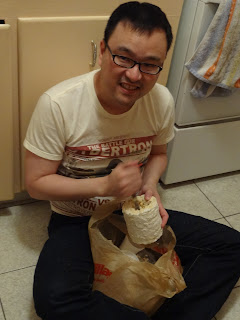Surroundings
The Iaido Seitei Manual describes each situation of the 12 kata prescribed by the ZNKR committee. They all begin with "detecting the harmful intent of your opponent". In everyday life, we encounter situations like these all the time. The intent may not be harmful, but the result could often have consequences. Whether minor or severe, we can learn to be aware of these possibilities and develop an appropriate proper response:
- I work in an office environment with cubicles that rise a couple of inches above my head. The maze of walls are ripe for accidental collisions to occur. I've learned to pay attention at these intersections, being prepared to step forward, back, or to the side if a careless associate were to come barrelling through.
- Have you ever gone to open a door, only for it to suddenly be opened by someone on the other side? Did you lose your balance and almost fall over? It doesn't take much effort to be aware of this possibility and simply balance your body before going for the handle.
- When walking down stairs, do you find your head bobbing up and down? This puts unnecessary pressure on your feet and knees. Try keeping yourself steady when the terrain changes. Your lower body and core muscles may get a work out, but it'll do wonders for your joints, spine, and upper body.
Actions
With knowledge that your life is part of your environment, you must realize that your actions, or lack of action, may affect others in immeasurable ways. You control how people see you, your associates, and your organization through your actions. One must always be aware of this perception, as these relationships help define who we are as people:
- Do you purposely hold doors open for strangers?
- Do you mindfully adjust your pace to match your companions?
- Do you regularly check up on someone important to you who you haven't seen in a while?
- Do you show appreciation for the people in your life?
Thoughts
While your actions affect how others perceive you, you must also be aware of how you perceive others, and ultimately, how you perceive yourself. We must continuously strive to improve these thoughts that guide our actions:
- Be hungry. To borrow a phrase from Steve Job's Stanford speech; where he urges new grads to never be satisfied. In Budo, the minimum years between gradings is not a criteria for passing, but an opportunity to re-dedicate yourself to the training and double your efforts. Simply making it through this period is not an accomplishment to be proud of.
- Be generous. Be mindful of all that you should be thankful for and share these benefits with others. Even the smallest gestures can mean a lot. Offer rides to seminars. Give positive feedback to your fellow students. Take an interest in each other as people who have their own unique experiences, motivations, and personality, and learn from them. Provide a welcoming environment to all who enter.
- Be courageous. Step out of your comfort zone and look to make a difference in your training (can you push yourself to work just a bit harder?), in your dojo (can you put aside your ego and dedicate yourself to the service of others?), and in the organization (can you look beyond what others can do for you, and contribute your time and energies to making everyone better?).
Can you make any of these your new years resolution? How about all of them?























